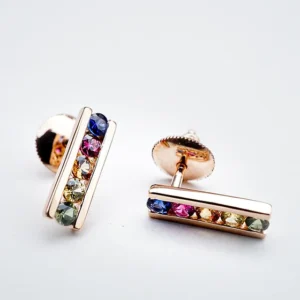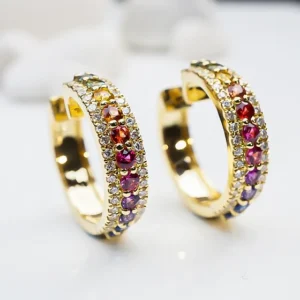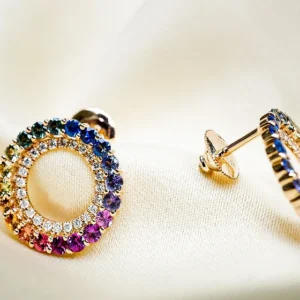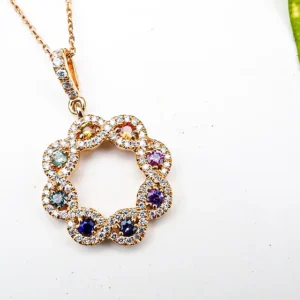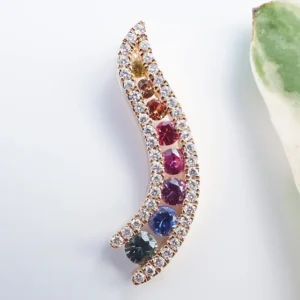Cushion Cut Diamonds: Unveiling the Brilliance of a Classic Choice
Diamonds, those precious and timeless gems, have captured the human imagination for centuries with their unmatched beauty and allure. Among the many captivating diamond cuts available, the cushion cut stands as a testament to both elegance and history.
Table of Contents
In this article, we will delve into the world of cushion cut diamonds, exploring their characteristics, history, popularity, and how to choose the perfect one for your special moments.
Cushion Cut Diamonds
A cushion cut diamond, brilliantly reflecting light from its facets.
Introduction
Diamonds, those precious and timeless gems that have adorned the crowns of kings and queens, graced the fingers of lovers, and sparkled in the most unforgettable moments of our lives, continue to hold an enchanting allure that transcends time and trends.
Among the myriad of diamond cuts that have captured human fascination, the cushion cut emerges as a true embodiment of elegance, blending the rich history of centuries past with the contemporary desires of today.
In this exploration, we will navigate through the facets of this remarkable cut, uncovering its unique features, delving into its historical journey, and understanding why it remains a cherished choice that symbolizes both the beauty of the past and the promises of the future.
The Allure of Cushion Cut Diamonds
What Sets Cushion Cut Diamonds Apart
Cushion cut diamonds, also known as “pillow-cut” diamonds, occupy a distinctive and revered position within the realm of gemstones. Their allure is derived from a captivating juxtaposition: the harmonious fusion of a square or rectangular silhouette, accentuated by delicately rounded corners, conjures an aesthetic reminiscent of a luxuriously plush cushion.
This remarkable synthesis of classic refinement and contemporary ingenuity not only imparts a timeless elegance but also elevates cushion cut diamonds to the forefront of desirability.
With a seamless ability to traverse the realms of tradition and modernity, these gems effortlessly grace both the ornate jewelry boxes of bygone eras and the chic showcases of present-day jewelry designers.
The Historical Significance
The rich tapestry of cushion cut diamonds’ history finds its roots entwined in the opulent fabric of the 19th century, a period characterized by elegance and refinement. It was during the resplendent epochs of the Georgian and Victorian eras that these diamonds first emerged as symbols of magnificence and grace.
Referred to as “old mine cuts,” these early iterations boasted facets of grand proportions that skillfully harnessed the diamond’s inner fire and brilliance, casting a mesmerizing spell in the warm glow of candlelit settings.
Over the passage of time, the cushion cut has embarked on an evolutionary journey, artfully weaving its vintage allure into the modern tapestry of gemstone preferences. As a result, the cushion cut diamond stands today as a masterful blend of yesteryear’s elegance and contemporary tastes, a testament to its enduring appeal and capacity to traverse the realms of history and modernity.
The Anatomy of Cushion Cut Diamonds
Facets and Fire: Brilliance Like No Other
Within the heart of every cushion cut diamond, a symphony of light unfolds through a meticulously crafted arrangement of facets that dance and shimmer in harmony. Ranging from 58 to 64 facets, each facet serves as a vital note in this luminous composition, collectively orchestrating the gem’s brilliance to its fullest potential.
It is the deliberate inclusion of larger facets that distinguishes the cushion cut from its counterparts, endowing it with a spellbinding ability to scatter light into a mesmerizing kaleidoscope of colors that flicker and cascade with every movement.
This enchanting play of light, reminiscent of the sun’s rays dancing on the surface of gentle waters, establishes a captivating visual narrative that sets cushion cut diamonds on a resplendent pedestal, a cut that dares to embrace the grandeur of light in ways that are uniquely its own.
The Shape Variations
The realm of cushion cut diamonds unfolds a realm of artistic diversity, where every facet arrangement tells a story of individuality and charm. As these precious gems grace the world with their presence, their inherent versatility reveals itself through a spectrum of silhouettes.
From the enchanting allure of rectangular cushions, which gently stretch the confines of tradition and lend an air of regal sophistication, to the captivating symmetry of nearly square cushions, evoking a harmonious equilibrium between tradition and modernity.
The decision between these variations becomes an intimate choice that echoes personal aesthetics and desires, for elongated cushion cut diamonds possess the magical ability to delicately elongate the finger, a statement of graceful elegance. Conversely, square cushions offer a visual equilibrium, adorning the hand with a balanced and symmetrical presence.
In this world of shapes, cushion cut diamonds empower individuals to curate their own narratives of beauty and style, shaping the very essence of their adornments and memories.
Factors Influencing the Beauty
Cut: The King of the 4 Cs
At the core of a captivating cushion cut diamond lies its cut—a masterful art that unlocks its brilliance and allure. This precise craft shapes facets to perfection, orchestrating a symphony of sparkle.
Experts emphasize balanced proportions, symmetry, and polished surfaces, a harmony that creates scintillation that mesmerizes and elevates the cushion cut diamond to a realm of luminous artistry.
Color Play: Optimal Choices
Cushion cut diamonds possess a unique ability to play with color, thanks to their distinct facets. Generally, a preference for near-colorless or subtly-tinted diamonds prevails. This is because the cushion cut’s light dispersion skillfully conceals faint color tints, adding to the gem’s visual allure and charm.
Clarity: Seeing Through Perfection
In the world of cushion cut diamonds, clarity is a delicate balance between flawlessness and uniqueness. Imperfections like inclusions and blemishes can be discreetly handled by the cut’s facets, but pursuing a higher clarity grade transforms the diamond into a captivating spectacle.
A diamond with superior clarity captures and reflects light with unmatched brilliance, inviting the beholder into a world of scintillating elegance where imperfections become inconspicuous, leaving behind a timeless allure.
Carat Weight: Finding the Ideal Balance
Selecting the right carat weight for a cushion cut diamond involves personal preferences and budget considerations. The cut’s larger facets create a visual illusion of size, making the diamond appear larger than its actual weight.
This unique attribute offers an affordable way to achieve a substantial look, where the cushion cut diamond balances elegance with practicality, embodying a blend of artistry and value.
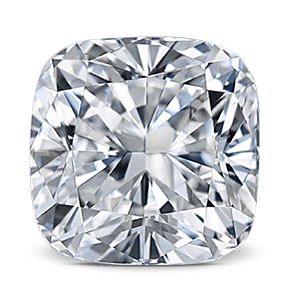
Cushion Cut Diamond
Choosing Your Perfect Cushion Cut Rings
When it comes to choosing your perfect cushion cut ring, the journey is a delightful exploration of personal style and heartfelt significance. The cushion cut diamond, with its intricate facets and alluring play of light, becomes the protagonist in a story of love and individuality.
As you embark on this meaningful decision, consider the symphony of factors that harmonize to create the ring of your dreams. From the delicate dance between cut and carat weight to the selection of a metal that resonates with your essence, each choice is a brushstroke on the canvas of a cherished memory.
The cushion cut’s remarkable versatility caters to a spectrum of tastes, be it a solitaire setting that stands as an emblem of timeless elegance or a halo design that exudes contemporary sophistication.
As you embark on this journey, let your heart guide you, for your cushion cut ring is a reflection of your love story, an embodiment of your unique journey, and a treasure that will forever adorn your hand with beauty and meaning.
Popularity and Celebrity Appeal
Redefining Elegance: Cushion Cut on the Red Carpet
The allure of cushion cut diamonds has extended its enchanting reach to the world of celebrities, becoming a symbol of sophistication and elegance that transcends both screens and red carpets. Notable Icons, including Jennifer Aniston and Sofia Vergara, have embraced the elegance of cushion cut engagement rings, setting trends and inspiring awe.
Their choice to embrace the cushion cut’s timeless grace has not only elevated their own jewelry collections but has also ignited a collective fascination, inspiring individuals around the globe to consider the regal charm of this cut for their own cherished moments.
As the world watches these stars shine with their cushion cut gems, a narrative of elegance and individuality emerges, intertwining the world of celebrity glamour with the enduring beauty of these remarkable diamonds.
Influences on Modern Jewelry
Modern jewelry designers have wholeheartedly embraced the versatility of the cushion cut, infusing their creations with a symphony of possibilities that celebrate individuality and love.
From the understated elegance of solitaire cushion cut diamond engagement rings that place the diamond’s allure front and center, to the intricate dance of light in cushion cut halo engagement ring settings that elevate romance to new heights, the cushion cut’s adaptability knows no bounds.
It has become a canvas for expression, where couples can curate their own love stories through the language of design.
Choosing the Perfect Cushion Cut Diamond
Determining Your Budget
Embarking on your diamond journey starts with a budget. Cushion cut diamond rings span a range of prices, catering to various budgets and ensuring accessibility without compromising on beauty.
Selecting the Right Cut
The cut quality directly impacts the diamond’s beauty. Aim for a cut grade that ensures optimal light performance, showcasing the diamond’s brilliance to its fullest extent.
Balancing Color and Clarity
When choosing a cushion cut diamond, consider a balance between color and clarity. This balance ensures a visually appealing stone without compromising on quality.
Size and Carat Considerations
Cushion cut diamonds provide a range of size options to suit individual preferences. Remember that the diamond’s appearance is influenced by factors beyond carat weight, such as cut and proportions.
Care and Maintenance
Cleaning Your Cushion Cut Diamond
Preserving your cushion cut diamond’s brilliance requires regular care. Use a mild detergent and warm water to gently brush the stone with a soft toothbrush. This simple routine removes accumulated wear, revealing the diamond’s innate radiance and ensuring its enduring enchantment.
Storage Tips for Lasting Sparkle
When not on your finger, keep your cushion cut diamond safe in a soft pouch or a dedicated compartment in your jewelry box. This safeguards it from scratches and preserves its brilliance by preventing dust and debris from settling on its facets, ensuring it remains ready to adorn you with its mesmerizing charm.
Customizing Jewelry with Cushion Cut Diamonds
Cushion cut diamonds offer more than beauty; they enable personalization. Customizing jewelry with these diamonds is an art that weaves individual stories into sparkling masterpieces. Every detail, from metal to setting, reflects personal significance, turning jewelry into a tangible symbol of memories and emotions that will shine across generations.
Cushion Cut Diamonds: Setting the Stage for Elegance
Cushion cut diamonds shine brilliantly in various settings, each enhancing their unique qualities. Here are some popular settings that showcase the elegance of oval cut diamonds:
Solitaire Setting
The solitaire setting stands as an embodiment of timeless simplicity and grace, a canvas where the cushion cut diamond takes center stage in all its resplendent glory. This classic design whispers of elegance, allowing the diamond’s inherent brilliance to speak volumes without distraction.
Nestled within a minimalist embrace, the cushion cut gem captures and reflects light with every facet, creating a mesmerizing dance of brilliance that draws the eye and warms the heart.
The solitaire setting is more than a design; it’s a celebration of purity, a symbol of unfaltering love and commitment. As the diamond rests upon the finger, the solitaire setting becomes a reflection of the wearer’s individuality and the boundless emotions that intertwine, transcending trends and echoing through the ages.
Halo Setting
The halo setting is a celestial embrace that elevates the cushion cut diamond’s allure. A circle of smaller diamonds encircles the center gem, casting a radiant halo that amplifies its brilliance. This design captures the essence of stars dancing in the night sky, infusing modern romance and symbolism.
As the cushion cut diamond rests within this luminous embrace, the halo setting becomes an embodiment of enduring love, casting an enchanting spell that resonates with every gaze.
Cathedral Setting
The cathedral setting is a regal design that elevates the cushion cut diamond with grace. Arches of metal rise to support the gem, capturing light from all angles and magnifying its brilliance. This setting symbolizes a union reaching for the heavens, reflecting a commitment that transcends earthly bounds.
As the cushion cut diamond graces the finger within this majestic embrace, it becomes a testament to enduring love and shared aspirations, casting a luminous light that persists through time.
Bezel Setting
The bezel setting offers modern protection as the cushion cut diamond is embraced by a metal band. This design exudes sleek sophistication and shields the gem from everyday wear. More than just a visual statement, it reflects enduring love’s strength, reminding wearers of both the diamond’s beauty and the resilience of their partnership.
Incorporating Cushion Cut Diamonds into Jewelry
Cushion Cut Engagement Rings
Cushion cut engagement rings, with their timeless allure and exquisite craftsmanship, hold the power to encapsulate love’s most cherished promises. The cushion cut diamond takes center stage in these captivating designs, its facets capturing and reflecting light with a brilliance that mirrors the spark of affection between two souls.
Each ring becomes a wearable testament to a journey of love, a tangible symbol of commitment that graces the finger and warms the heart. From the classic elegance of a solitaire setting to the contemporary enchantment of a halo or a bezel design, cushion cut engagement rings embody a fusion of tradition and innovation, each one encapsulating a unique love story.
As fingers are adorned with these tokens of affection, a narrative unfolds—of whispered promises, shared dreams, and a future intertwined. The cushion cut engagement ring, in all its splendor, transcends jewelry; it is an embodiment of emotions, a vessel that holds the eternal promise of a love that knows no bounds.
Necklaces and Pendants
Necklaces and pendants featuring cushion cut diamonds offer a timeless elegance that graces the neckline with sophistication. These pieces become luminous focal points, capturing attention and sparking conversations. Whether as single pendants or part of an ensemble, each necklace or pendant carries a story—a reminder of cherished moments and deep emotions.
Worn close to the heart, these jewels embody more than style; they symbolize love and individuality, casting a lasting glow that transcends trends and enriches personal narratives.
Earrings
Cushion cut diamond earrings elevate adornment, framing the face with captivating light. Whether in classic studs or intricate chandeliers, these jewels captivate and add elegance. With every movement, they scatter light, adding allure to the wearer’s visage.
More than accessories, cushion cut diamond earrings become cherished companions, gracing occasions and everyday moments with timeless grace and brilliance.
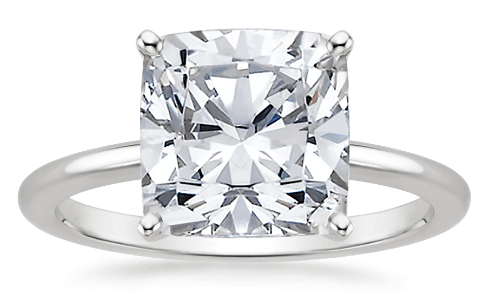
A Cushion Cut Diamond Solitaire Ring
Investment Value and Future Trends
Cushion Cuts as Investments
Cushion cut diamonds possess both emotional and financial value. Their timeless charm and celebrity endorsements make them enduring investments. Beyond their beauty, their versatility aligns with different eras, ensuring lasting relevance.
Choosing cushion cut diamonds means embracing symbols of love and making wise investments, combining emotional and financial significance in a single gem.
Emerging Trends in Diamond Preferences
As jewelry trends evolve, cushion cut diamonds are set to charm for years to come. Their blend of vintage charm and modern aesthetics aligns perfectly with contemporary preferences, ensuring their timeless appeal. Adapting to changing tastes, cushion cut diamonds remain an eternal favorite, symbolizing enduring love and bridging the gap between tradition and innovation.
Making Memories: Cushion Cut Diamond Engagement Rings
Capturing the Romance
Cushion cut diamond engagement rings offer a romantic and elegant choice, symbolizing the love and commitment between partners. Their soft curves and dazzling brilliance reflect a bond that comforts and supports, capturing the essence of a shared journey.
Beyond aesthetics, these diamonds embody a unique love story, making them a meaningful and beautiful choice for expressing profound emotions and shared dreams.
Customization for Individuality
Engagement rings with cushion cut diamonds offer endless personalization, reflecting your story and style. From delicate solitaires to intricate cushion cut halo engagement rings, the options are limitless. Each setting becomes a symbol of your unique journey, a treasure that captures your love’s essence and transcends trends.
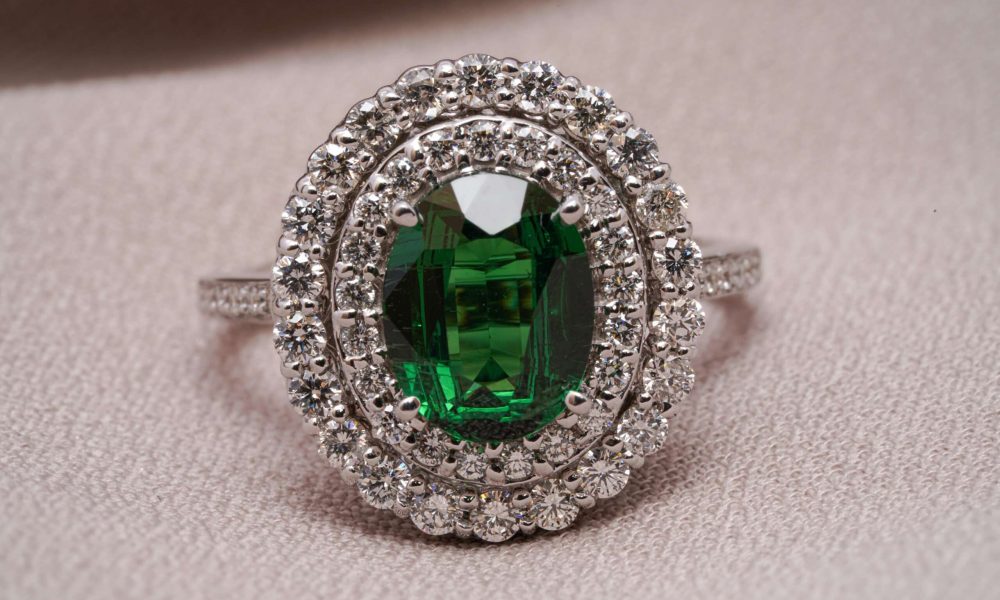
A Gemstone Ring
Final Thoughts
The world of cushion cut diamonds unfolds as a tapestry woven with brilliance, emotion, and timeless elegance. From their rich history dating back to the 19th century to their resounding popularity among celebrities and modern couples alike, cushion cut diamonds have proven their enduring charm.
With a blend of vintage allure and contemporary aesthetics, these gems stand as exquisite testaments to the power of love and commitment. Whether gracing engagement rings, necklaces, pendants, or earrings, cushion cut diamonds encapsulate personal stories and emotions, illuminating not only the wearer but also the memories and aspirations they symbolize.
As you embark on your journey to find the perfect cushion cut gem, remember that each facet reflects not just light, but the unique moments that define your journey—a journey that now sparkles with the brilliance of these remarkable diamonds.
FAQs About Cushion Cut Diamonds
A cushion cut diamond is a square or rectangular diamond shape with rounded corners, resembling a plush cushion. It's known for its blend of classic and contemporary design, offering a unique play of light.
Cushion cut diamonds typically have 58 to 64 facets, each contributing to their mesmerizing brilliance and color dispersion.
The cushion cut's facet arrangement contributes to its exceptional light dispersion, creating flashes of color and light that set it apart from other diamond cuts.
Yes, cushion cut diamonds can vary in shape, ranging from nearly square to more rectangular. This customization allows individuals to choose a shape that suits their personal preference.
The best setting for a cushion cut engagement ring depends on individual taste. Options include classic solitaire, halo, cathedral, and bezel settings, each offering a unique appeal.
Yes, cushion cut diamonds trace back to the 19th century and were popular during the Georgian and Victorian eras. Early versions, known as "old mine cuts," showcased the diamond's fire and brilliance in candlelit settings.
Yes, cushion cut diamonds can be a good investment due to their enduring popularity and timeless appeal. Their value may appreciate over time, especially for well-cut and high-quality stones.
To care for cushion cut diamond jewelry, store it in a soft pouch or a separate compartment in your jewelry box to prevent scratches and dust accumulation. Regular cleaning using mild detergent and warm water will help maintain its luster.
Absolutely, cushion cut diamonds can be customized in a variety of settings and styles. From solitaire to halo and more, the versatility of this cut allows for personalization that reflects individual taste and preferences.
Cushion cut diamonds symbolize enduring love through their blend of vintage charm and contemporary aesthetics. Their soft curves and captivating brilliance encapsulate the essence of a love that withstands the test of time, making them a perfect choice for engagement rings and cherished jewelry pieces.

